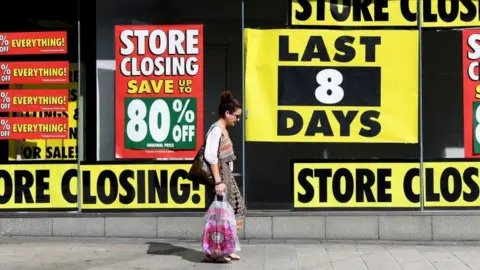Retailers shut 2,870 stores in first half of 2019
 Getty Images
Getty ImagesAbout 16 shops are closing every day as retailers restructure their businesses and more shopping moves online.
A net 1,234 stores shut on Britain's top 500 high streets in the first half of the year, according to research by PwC and the Local Data Company.
That is up from 1,123 in the same period last year and the highest since the survey began in 2010.
Fashion retailers saw the biggest declines in the period, followed by restaurants, estate agents and pubs.
However, there were more openings of takeaways and sport and health clubs.
Lisa Hooker, consumer markets leader at PwC, said: "The decline in store numbers in the first half of 2019 shows that there's been no let-up in the changing ways that people shop and the cost pressures affecting High Street operators."
She said retailers had to invest more in making stores "relevant to today's consumers", but added that "new and different types of operators" needed encouragement to fill vacant space.
According to PwC, 1,634 stores opened in the six months to the end of June - a 4% increase on the same period last year - while 2,868 stores shut. The data looks at retail chains with more than five outlets.
High profile administrations
High Street retailers continue to face growing competition from online operators such as Amazon, making it harder to pay their rents and other overheads, such as a rising minimum wage and business rates.
It has led to big names such as Toys R Us going into administration, while others such as Topshop-owner Arcadia, Debenhams and New Look have announced large-scale closures.
According to PwC, fashion retail continued to be the hardest hit sector in the six months to June, with 10 stores a week closing, mainly as a result of high profile administrations and restructurings
Meanwhile, there were net declines of 103 restaurants, 100 estate agents and 96 pubs.
Greater London saw the largest number of net closures of any region, although when taking into account its higher number of shops, its closure rate was in line with the national average.
The East Midlands, North East, South East and Yorkshire and the Humber were the only regions to see fewer closures than last year.